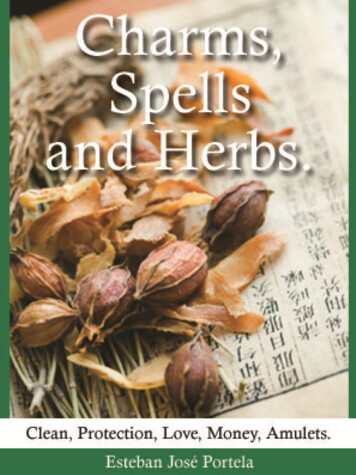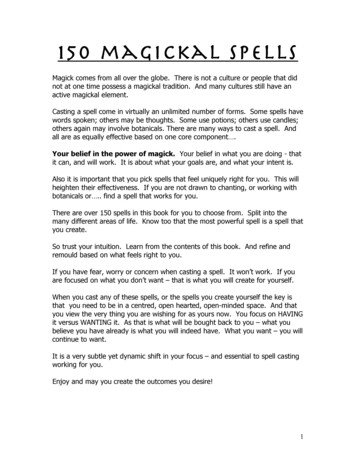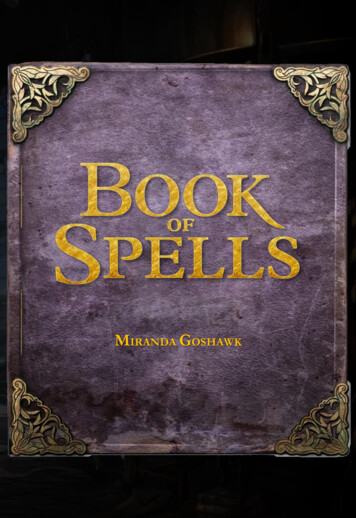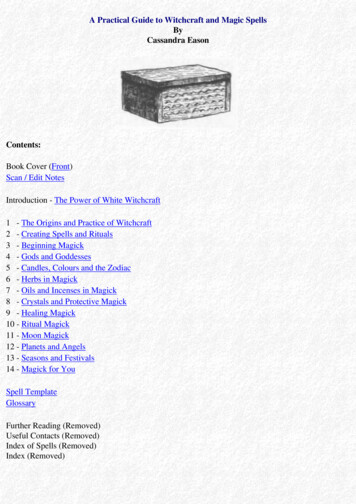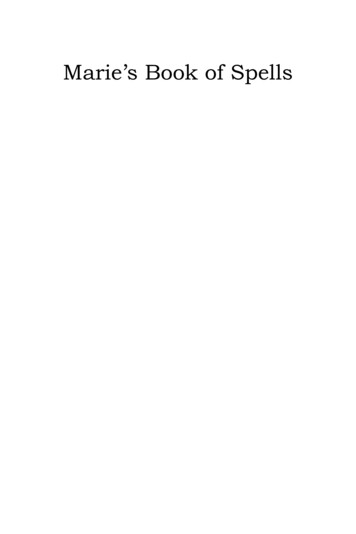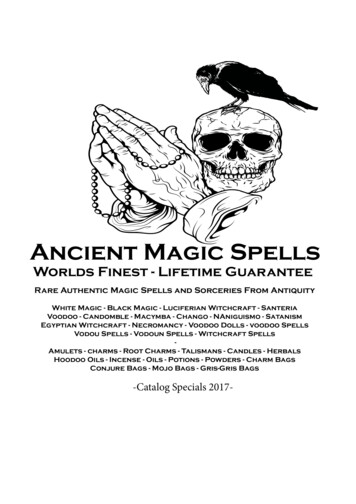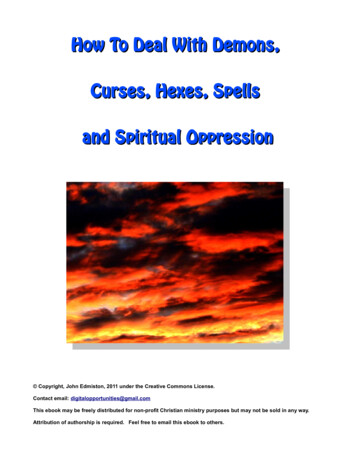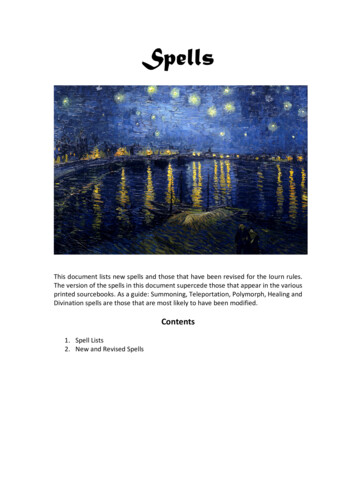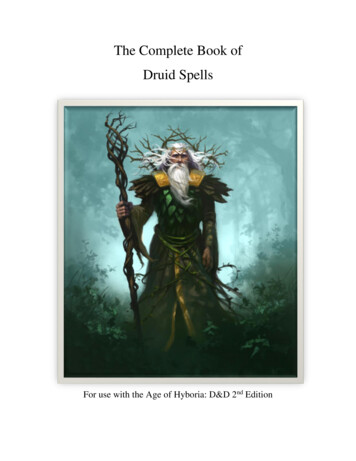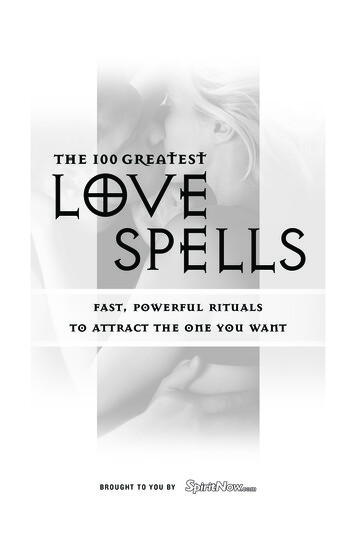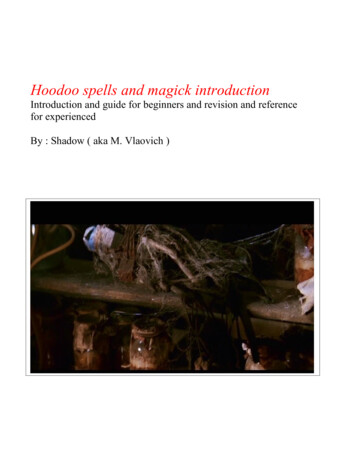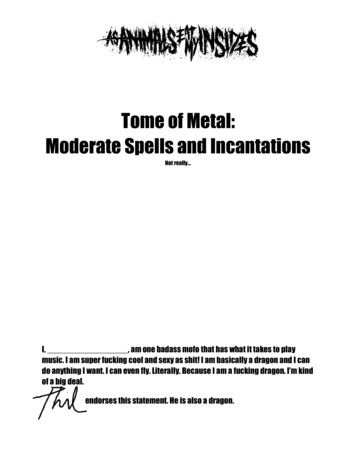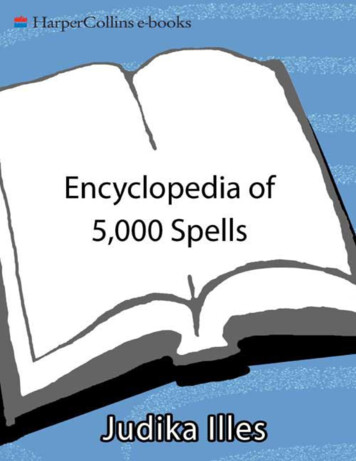
Transcription
JUDIKA ILLESTheEncyclopediaof 5000 Spells
For Herta and Zoltan Illes, and Rachel and Jordan Nagengast, without whose love, patience, and support this book could never have been written.
Magic is the ancient and absolute science of nature and absolute science of nature andher lawsA. L. CONSTANT, THE HISTORY OF MAGIC, LONDON, 1922
ContentsCoverTitle PagePrefaceIntroductionPART ONE: Elements of Magic SpellsSpell-castingKey Concepts for Casting Magic SpellsRitual Tools and TechniquesUsing this bookPART TWO: The SpellsAnimal SpellsBanishing SpellsBetter Business and Professional Success SpellsCleansing SpillsCourtcase Spells: Legal Spells and Spells for JusticeDeath Spells: Death, Ghosts, Necromancy, and VampiresDivination SpellsSpell of Domination, Persuasion, and InfluenceDream Spells: Dreams, Insomnia, Nightmares, Astral Projection, and Witches’ Flying PotionsThe Evil EyeFertility: Spells for Conception and ContraceptionFire Safety SpellsGamblers’ Spells and CharmsHappy Home SpellsHealing SpellsHexes and their AntidotesInvisibility and Transformation SpellsLove Magic: Spells for Romance, True Love, Seduction, and SexLuck and Success SpellsMarriage and Diuorce SpellsMoney Spells: Spells for Wealth, Prosperity, and Financial StabilityPregnancy and Childbirth Spells: Spells to Protect Mothers and InfantsProtection SpellsPsychic Power SpellsSpells for TravelersSpirit Summoning SpellsTheft, Lost Objects, and Missing PersonsUnblocking SpellsWeather SpellsYouth, Beauty, and Longevity SpellsFormularyTablesBibliographyBotanical ClassificationsIndexWARNING!AcknowledgementsAbout the AuthorCopyrightAbout the Publisher
PrefaceThe image is so familiar as to qualify as an archetype. It appears in countless movies, television shows, and theatrical productions. If you’reof a literary bent, you’ll find it in countless novels, too. Although there may be variations on the theme, the core image remains consistent: someone,usually but not always a witch or wizard, faced with a serious dilemma, reaches for a massive book of magic spells.The contents of this book are rarely displayed. (An exception occurs on the television series, Sabrina the Teenage Witch. As befitting a twenty-firstcentury witch, Sabrina’s edition is interactive.) Oversized, well-worn, and clearly used, this book is obviously no coffee-table book but a familiarcompanion—in every sense of the word familiar. Sabrina’s book makes almost as many appearances as her black cat, and consistently proves morereliable.The book’s very presence transmits subliminal messages. If there were previously any doubts regarding someone’s identity, then the act of reaching forthe book, mere possession of this book in fact, is usually sufficient to establish occult credentials. Consider depictions of Merlin or Morgan le Fay: theirbig books of spells are as much a part and parcel of their magical trappings as any animal familiar, crystal ball, or wizard’s robes. Millions of kitschystatues feature an elderly gray-bearded man clutching a massive book. He may or may not be wearing his peaked wizard’s hat but his identity is clear.How do we know he’s a wizard? By the book that he holds.This book thus signals that its reader is a metaphysician or is striving to be one. If the reader handles the book with comfort and ease, the implication isthat he or she is a person of power. The book, however, can also compensate for the reader’s very lack of experience and knowledge. One frequentvariation on the theme depicts a complete novice discovering sophisticated magical solutions within the book’s pages. Typically the novice is in way overhis head in disaster. The very appearance of the book signals that salvation is at hand: the secrets of salvation are contained within the book’s pages, ifonly the novice will follow its directions. (Conversely, Mickey Mouse’s inability to use such a book for anything other than a flotation device in TheSorcerer’s Apprentice only underscores his magical ineptitude and general incompetence.)This massive spell book thus possesses enormous transformative powers. It can transform anyone (well, Mickey excepted) into a magical adept. Itsaged, well-worn appearance also indicates that this book is timeless: it never outlives its usefulness.The appearance of this book within this scenario also underscores that the situation at hand is genuinely an emergency Subliminally, it is understoodthat no matter how extensive the library, this is the real deal book, the authentic article brought out when there is no time to lose. In the image, the handthat reaches for the book never wavers. The gesture is always sure. Regardless how many books are crammed onto the bookshelf, the hand reaches forone and only one book. An extension of the core image often shows the seeker desperately turning pages to no avail. The book is thrust down in despair;the seeker is left to either yield to bitter fate or else to creatively conjure his or her own solutions. There is no suggestion that perhaps another book holdsthe key. If it’s not in the big book of spells, there’s no point looking elsewhere.This archetypal book is based on both fact and fantasy.Collections of spells rank among Earth’s earliest written documents. Not only are magical texts among the oldest surviving pieces of literature, but manyscholars and anthropologists suggest that it was the need to record spells and divination results that stimulated the very birth of writing. Magic, as we willsee, is the true mother of invention. In ancient Egypt, the lunar god Thoth is credited as the inventor of both magic and writing. He is the patron of scribesand magicians. It was rumored that in addition to inventing the systems of spelling and writing, Thoth created the very first book, authoring no less than asacred revelation of Earth’s most powerful secret spells and rituals. The legendary Book of Thoth was believed to hold the key to all the secrets of theuniverse. To possess a copy of the book enabled one to command and control destiny itself.The ancient Egyptians loved stories featuring books of power. Several of their legends remain to us, including the original version of Walt Disney’s TheSorcerer’s Apprentice. Egypt, at the time, was a theocracy: religion and government were one. The reigning pharaoh was simultaneously the child of thegod, the living embodiment of the god, and the god’s foremost high priest, and vast temple complexes, financed by the state, contained literary annexesknown as Houses of Life.These combination scriptoria/emergency clinics housed wizard priests, on the government payroll. For a fee, these professional magicians wouldconsult their extensive library of magic texts to provide clientele with enchanted solutions to life’s many dilemmas. Perhaps, legend had it, the Book ofThoth was hidden in the depths of one of these magic libraries. Perhaps it was stashed in some priest or pharaoh’s tomb. Or perhaps it was eventuallydeemed so dangerous that, too powerful to destroy, the book had been locked into a chained, weighted iron box and thrown into the depths of the sea.Access to occult knowledge bestowed power and prestige. The magical texts were hoarded and kept secret. Many were written in code, to preventprofane eyes from understanding what was read.A few centuries before the dawning of the Common Era, the independent Egyptian nation was defeated, first by the Persians, then by the Greeks andRomans. Indigenous Egyptian religion and political structure degenerated. The Houses of Life were abandoned; the lucrative, respected profession ofgovernment-employed wizard-priest no longer existed. It was the last time in history that working with magic was a secure, respectable profession.Although the profession ceased to exist, the big spell books survived, at least in fragments. It’s difficult for modern readers, so accustomed to printed,standardized texts, to recall that until the invention of the printing press, every book was hand-written and frequently unbound. Copies of copies of copieswere made, each perhaps slightly different than the next. In the chaos that ensued as Egypt was successively conquered, individual pages were eithersmuggled out of the now unguarded temple libraries as personal treasures or auctioned off, page-by-page, papyrus by papyrus for personal profit. WhenAlexandria’s famed library, which boasted a copy of every book then in existence (the city stole them from arriving ships), was burned to the ground, thevalue of the few surviving manuscripts increased.With the rise of Christianity, magic, together with its texts and professionals, was vilified. Spell books were burned en masse. Yet some were saved, ifnot whole books, then individual pages and pieces. We know this to be true, because some still remain, their spells reproduced in many books includingthis one, preserved at great personal risk throughout the ages, during eras where possession of magical texts warranted the death penalty.These treasured pages survived, secretly passed between adepts and initiates, as did legends of mysterious books of power just waiting to berecovered. The Book of Thoth is one but there were others: The Book of Raziel is a rival with Thoth’s book for the title of first book ever. Another book ofspells and rituals, The Book of Raziel was allegedly written by a sympathetic angel and given to Adam to compensate for his exile from Eden. Rumorsregarding the existence of magical manuscripts attributed to Israel’s wizard king, Solomon, were first recorded, at least as far as we know, during the timeof Josephus, the first-century chronicler of the Roman conquest of Judea. Fragments of Solomon’s pages were allegedly discovered and exist today.Treasure hunters searched desperately for these manuscripts, just like Sidney Greenstreet looking for the Maltese falcon.In the fourteenth century, a large group of nomadic people arrived in Europe from parts unknown. Although the Romany people derive originally fromIndia, another land steeped in magical and spiritual legend, they may or may not also have spent considerable time in Egypt. (According to some Romanylegends, their ancestor was the sole survivor of Pharaoh’s army, drowned in the Red Sea.) The association with Egypt was powerful enough andappealing enough that Europeans called the Romany Egyptians, the name eventually being corrupted into Gypsies.At the same time as the arrival of the Romany, a deck of mysterious cards began to circulate through Europe. Rumors spread that these tarot cardswere what was left of the Book of Thoth. Readers scoured them searching for spiritual secrets and clues for obtaining personal power.
With the advent of the printing press came publication and standardization of spell books. Enough were published to warrant their own literary category,the grimoire. The word, “grimoire,” defined as a book of spells, is related to grammar. The grimoire is basically another type of grammar book, justteaching different spelling skills. The classic grimoires were published in the midst of anti-magic, anti-witchcraft persecutions and, like alchemists’ texts,they are often heavily coded to protect authors, compilers, and publishers, and also to maintain secrecy and control over their precious information,reserving true comprehension for a private club of initiated adepts.On the whole, grimoires are not books of practical magic. The novice cannot pick one up and instantly begin casting life-saving spells. Instead they arelargely oriented towards an educated male reader so devoted to his spiritual path that he has largely withdrawn from everyday life, like Dr. Faust, and canthus spend weeks in complex, tortuous preparation for summoning angels and demons.Other books of magic circulated through Europe. These were still hand-written rather than printed editions. Books of Shadows meticulously recorded anindividual witch’s personal spells and knowledge. These books were intended to be passed from person to person, but as a means of saving persecutedtraditions from complete eradication. Few of these books remain. When a witch was caught, convicted, and killed, her Book of Shadows was inevitablydestroyed with her. Modern Wicca has, however, revived the tradition of beautiful, lovingly preserved personal spell and ritual books.Neither the Books of Shadows, nor the classic grimoires fulfill the Hollywood fantasy of that large, accessible book packed with every spell you mightpossibly need. One mustn’t mock that vision: we long for magical solutions to insoluble situations. We crave the inherent promise of the hidden Book ofThoth. We long to discover that one word of power strong enough to stop the sun in its tracks if we utter it, potent enough to vanquish our enemies, fill ourbank accounts, and deliver our true love.Perhaps somewhere, someday, in some archaeological dig, that Book of Thoth will be found.Until then, here is The Encyclopedia of 5000 Spells: five thousand spells drawn from all over Earth, from ancient to modern Egypt, old Mesopotamia totoday’s African Diaspora. There are spells from every continent, from Celtic, Italian, Jewish, and Romany traditions. There’s practical magic, high ritualmagic, spells requiring virtually no preparation, and spells that should perhaps never be performed. No secret code has been applied; instead there areexplanations so that you understand how and why the spells should work.Be forewarned: in these pages you will discover methods of communicating with the dead, taming an errant lover, summoning spirits, handcraftingmagic tools, and tips for creating magic mirrors and rings—including the one that allegedly gave Helen of Troy her seductive power. I will tell you up-front,however, this book does not contain that sole word of power, guaranteed to stop the sun and fulfill your every desire.Perhaps one day you will find the volume that contains that one word, although the ancient Egyptians warned that in order to attain it you migh
usually but not always a witch or wizard, faced with a serious dilemma, reaches for a massive book of magic spells. The contents of this book are rarely displayed. (An exception occurs on the television series, Sabrina the Teenage Witch. As befitting a twenty-first-century witch, Sabrina’s edition is interactive.) Oversized, well-worn, and clearly used, this book is obviously no coffee-table .
